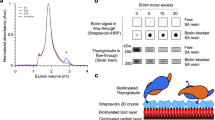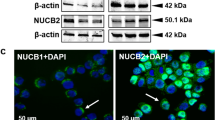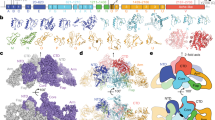Abstract
The amino acid sequences of peptide hormones that terminate in an α-amide group seem usually to be followed by glycine in the sequence of their precursor molecules. Thus it has long been known that the sequence of α-melanotropin, which terminates in Lys-Pro-Val-CONH2 (ref. 1), occurs adjacent to glycine in the sequence of corticotropin2 and more recently it has been shown that the peptide hormone mellitin, which terminates in glutamine amide3, is synthesized as a prohormone that terminates in glutaminyl-glycine4. A similar relationship is suggested by comparison of the primary structures of adipokinetic hormone5 and red pigment-concentrating hormone6. These observations indicate that biosynthesis of the C-terminal amide may involve the action of a specific enzyme which has a requirement for C-terminal glycine. We present here direct evidence that porcine pituitary contains an enzyme with the ability to convert peptides that terminate in glycine to the corresponding des-glycine peptide amide. We have investigated the substrate specificity of the enzyme and with the aid of isotopic labelling have demonstrated that its mechanism of action involves dehydrogenation and hydrolysis of the glycine-containing substrate.
This is a preview of subscription content, access via your institution
Access options
Subscribe to this journal
Receive 51 print issues and online access
$199.00 per year
only $3.90 per issue
Buy this article
- Purchase on Springer Link
- Instant access to full article PDF
Prices may be subject to local taxes which are calculated during checkout
Similar content being viewed by others
References
Harris, G. I. & Lerner, A. B. Nature 179, 1346–1347 (1957).
Shepherd, R. G. et al. J. Am. chem. Soc. 78, 5067–5076 (1956).
Habermann, E. & Jentsch, J. J. Physiol. Chemie. 348, 37–50 (1967).
Suchanek, G. & Kreil, G. Proc. natn. Acad. Sci. U.S.A. 74, 975–978 (1977).
Stone, J. V., Mordue, W., Batley, K. E. & Morris, H. R. Nature 263, 207–211 (1976).
Fernhurd, P. Biochim. biophys. Acta 371, 304–311 (1974).
Jacobs, L. S., McKeel, D. W., Jarett, L. & Daughaday, W. H. Endocrinology 92, 477–486 (1973).
Engelfried, C., Koenig, W. A. & Voelter, W. Biomed. Mass Spectrom. 3, 241–244 (1976).
Scott, A. P. et al. Nature 244, 65 (1973).
Fruton, J. S., Johnson, R. B. & Fried, M. J. biol. Chem. 190, 39–53 (1951).
Gross, E. in Peptides, Chemistry, Structure and Biology (eds Walter, R. & Meienhofer, J.) 31–42 (Ann Arbor Science, Michigan, 1975).
Barrett, G. C., Chowdhury, L. A. & Usmani, A. A. Tetrahedron Lett. 2063 (1978).
Land, H., Schütz, G., Schmale, H. & Richter, D. Nature 295, 299–303 (1982).
Amara, S. G., David, D. N., Rosenfeld, M. G., Roos, B. A. & Evans, R. M. Proc. natn. Acad. Sci. U.S.A. 77, 4444–4448 (1980).
Author information
Authors and Affiliations
Rights and permissions
About this article
Cite this article
Bradbury, A., Finnie, M. & Smyth, D. Mechanism of C-terminal amide formation by pituitary enzymes. Nature 298, 686–688 (1982). https://doi.org/10.1038/298686a0
Received:
Accepted:
Issue Date:
DOI: https://doi.org/10.1038/298686a0
This article is cited by
-
Novel insights into peptide amidation and amidating activity in the human circulation
Scientific Reports (2021)
-
RNAi mediated myosuppressin deficiency affects muscle development and survival in the salmon louse (Lepeophtheirus salmonis)
Scientific Reports (2019)
-
Analytic framework for peptidomics applied to large-scale neuropeptide identification
Nature Communications (2016)
-
Structure-based Mechanistic Insights into Terminal Amide Synthase in Nosiheptide-Represented Thiopeptides Biosynthesis
Scientific Reports (2015)
-
Itch-Associated Peptides: RNA-Seq and Bioinformatic Analysis of Natriuretic Precursor Peptide B and Gastrin Releasing Peptide in Dorsal Root and Trigeminal Ganglia, and the Spinal Cord
Molecular Pain (2014)
Comments
By submitting a comment you agree to abide by our Terms and Community Guidelines. If you find something abusive or that does not comply with our terms or guidelines please flag it as inappropriate.



